TS 22.079
SOR —
Support of Optimal Routeing –
Stage 1
V18.0.1 (PDF)
2024/03 17 p.
V17.0.0
2022/03 17 p.
V16.0.0
2020/06 17 p.
V15.0.0
2018/06 17 p.
V14.0.0
2017/03 17 p.
V13.0.0
2015/12 17 p.
V12.0.0
2014/10 17 p.
V11.0.0
2012/09 17 p.
V10.0.0
2011/04 17 p.
V9.0.0
2009/12 17 p.
V8.0.0
2009/01 17 p.
V7.0.0
2007/06 17 p.
V6.0.0
2004/12 17 p.
V5.0.0
2002/07 17 p.
V4.0.0
2001/04 17 p.
V3.0.1
1999/10 17 p.
GSM Rel-98 v7.0.0
1999/06 16 p.
GSM Rel-97 v6.0.0
1998/10 16 p.
GSM Rel-96 v5.2.0
1999/02 18 p.
- Rapporteur:
- Dr. Scarrone, Enrico
Telecom Italia S.p.A
Content for TS 22.079 Word version: 18.0.1
1 Scope p. 5
This Stage 1 description of the first phase of Support of Optimal Routing (SOR):
- compiles the basic service requirements for SOR;
- describes the interactions for Supplementary Services (SS) in order to cater for SOR;
- refers to modifications to network features required by SOR.
- There is no need for optimisation of the routing of calls originally directed to a fixed network subscriber, because the physical address of a fixed network terminating line cannot differ from its logical address.
- SOR in non-PLMNs is not a subject of this TS, but might be possible by bilateral arrangement between PLMN operators and those non-PLMN operators.
- OR for the benefit of the B party i.e. Mobile terminated calls with late call forwarding to the home or visited country (scenarios 1 and 2),
- OR for the benefit of the A party, e.g. Mobile to mobile calls where both mobile subscribers are in the same country (scenarios 3 to 10).
2 References p. 5
The following documents contain provisions which, through reference in this text, constitute provisions of the present document.
- References are either specific (identified by date of publication, edition number, version number, etc.) or non-specific.
- For a specific reference, subsequent revisions do not apply.
- For a non-specific reference, the latest version applies. In the case of a reference to a 3GPP document (including a GSM document), a non-specific reference implicitly refers to the latest version of that document in the same Release as the present document.
3 Definitions and abbreviations p. 5
Administrative PLMN:
The complete set of all functional entities normally regarded as a single PLMN.
Basic OR:
Routeing of a call by the direct route when no forwarding occurs.
Direct route:
A call uses the direct route if it is routed from the serving network of the original calling party to the serving network of the ultimate called party without any intermediate PLMN.
HPLMN route:
A call uses the HPLMN route if the destination is deduced from the MSISDN of the called party. This forces the call to be routed via the HPLMN of the called party.
HPLMN leg:
The HPLMN leg is that part of the HPLMN route from the IPLMN to the HPLMN of the called party.
IPLMN:
An IPLMN is a PLMN which interrogates the HPLMN of a called party in order to determine the whereabouts of that party.
Early Call Forwarding :
Early Call Forwarding is Call Forwarding performed from the IPLMN before the call has been extended to the VPLMN of the forwarding subscriber (i.e. Call Forwarding Unconditional and Conditional Call Forwarding on Not Reachable known at the IPLMN before extension of the call)
Functional PLMN:
For the purposes of this description the Administrative PLMN is divided into functional PLMNs that represent different aspects of the Optimal Routeing functionality.
Late Call Forwarding:
Late Call Forwarding is Call Forwarding performed after the call has been extended to the VPLMN of the forwarding subscriber (i.e. Conditional Call Forwarding on Busy, Conditional Call Forwarding on No Reply and Conditional Call Forwarding on Not Reachable detected in the VPLMN of the forwarding subscriber). Late Call Forwarding may be invoked in the IPLMN or in the VPLMN of the forwarding subscriber.
Special mobile network number:
For the purposes of this description special mobile network numbers are numbers belonging logically to a PLMN but not to a mobile subscriber. Examples are the customer service number or value added service numbers.
Abbreviations are given in TR 21.905.
4 Description of Optimal Routing p. 6
Support of Optimal Routing (SOR) is a network feature which enables the calls directed to a mobile subscriber to be routed directly to the mobile subscriber's actual location, or to her forwarded-to destination (instead of via the HPLMN or in the case of Late Call Forwarding via the VPLMN).
The IPLMN handling the call shall decide whether or not to optimise the routing of the call taking into account information provided by the called mobile subscriber's HPLMN. For given subscribers, as a network option, the HPLMN may permit or deny OR on a per call basis.
5 Functional requirements p. 6
5.1 General p. 6
SOR shall be provided for all circuit switched Telecommunication Services, except emergency calls, Dedicated PAD and Dedicated Packet Access (GPRS is for further study).
The network feature shall be applied automatically for all calls except for those calls for which the HPLMN of the called party denies the optimal routing.
5.2 Normal operation p. 6
In the first phase of SOR, the routes of calls will be optimised for the cases of OR being performed within a country or towards the country where the call would have been routed normally.
Under all other circumstances, the basic call routing is applied:
- If the IPLMN detects that basic OR cannot be applied, the IPLMN routes the call according to the dialled number.
- If the IPLMN detects that OR for Late Call Forwarding cannot be applied, the Call Forwarding will be performed in the VPLMN of the forwarding subscriber.

If one of those scenarios occurs, SOR shall be invoked.
The assumptions taken are the following :
- A subscriber A sets up a call to a mobile subscriber B, who may have forwarded her calls to a subscriber C.
- The C subscriber may be either a fixed subscriber or a mobile subscriber.
5.2.1 A is a fixed subscriber or a mobile subscriber who may not benefit from OR p. 7
As the originating network does not have the ability to interrogate the HPLMN of the B subscriber, the normal call handling is applied.
Once the HPLMN of the B subscriber has the control of the call, the call may be optimised in the case of a forwarded call towards a party located in the Home Country of the B subscriber or in the country visited by the B subscriber.
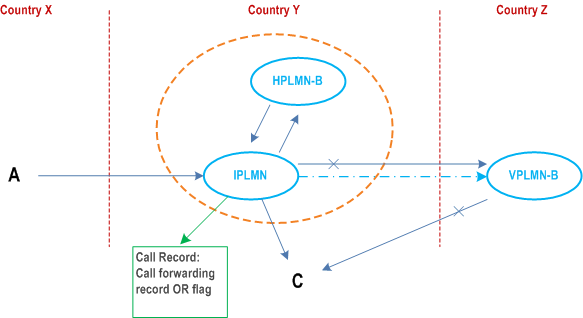

5.2.2 A is a mobile subscriber who may benefit from OR p. 8
5.2.2.1 Description of the call routing p. 8
If A sets up a call to B, then the originating PLMN shall interrogate the HPLMN of the mobile subscriber B in order to know how to route the call.
If B is registered in the same country as A, then the call shall be routed directly to B as described below.
If B has activated a Call Forward to a destination located in the Home Country of B or in the country where A is registered and this leads to the invocation of Early Call Forwarding, then the call shall be routed directly from A to the forwarded-to-party.
In any other cases, the call shall be routed to the mobile subscriber B via HPLMN(B).
If the call cannot be completed, the originating PLMN shall receive an indication of the reason of the failure of the call completion.
Thereafter, if the mobile subscriber B has activated a Conditional Call Forward to a destination located in her Home Country or to a destination in the country where A is registered and this leads to the invocation of Late Call Forwarding, then the originating PLMN shall route the call directly to the forwarded-to-party.
The remaining leg of the call from the intermediate point to the ultimate destination may be optimally routed.
5.2.2.2 Call scenarios handled in OR Phase 1 p. 9
In the following scenarios, the IPLMN is VPLMN-A.
1) The call from the A subscriber to the B subscriber is completed (Basic OR)
a) B is located in the same country as A
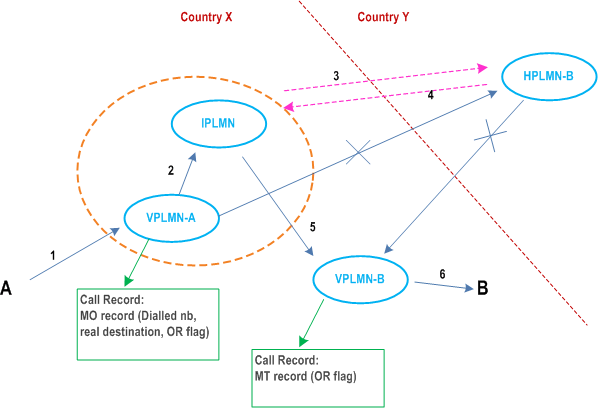
b) B is located in her Home Country (Network usage optimization)
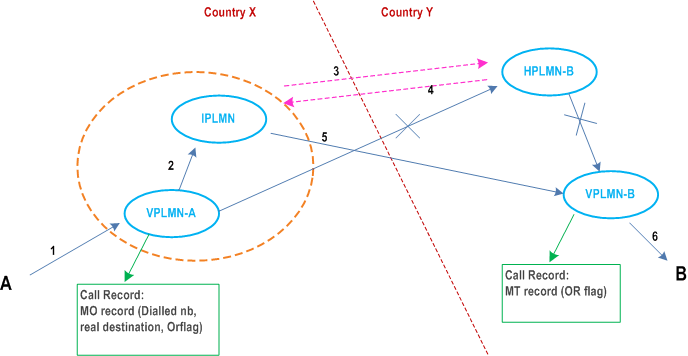
2) The call set up by the subscriber A is being forwarded to a C party
2.1) Early Call Forward
a) the C party is in the same country as the A subscriber, but different from HPLMN B country.
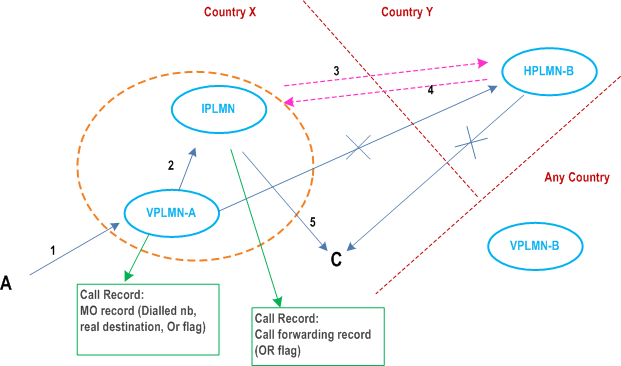
b) the C party is in the same country as HPLMN-B
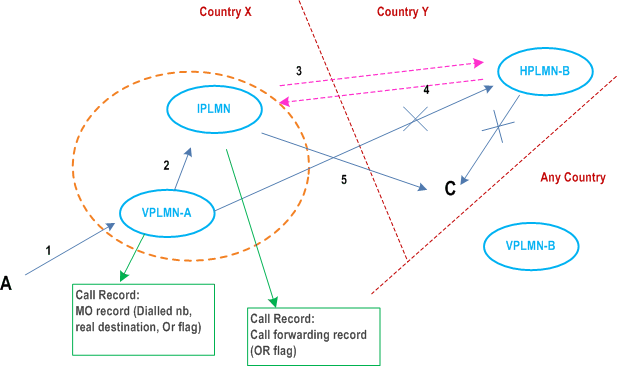
2.2) Late Call Forward
a) B and C are in the same country as A
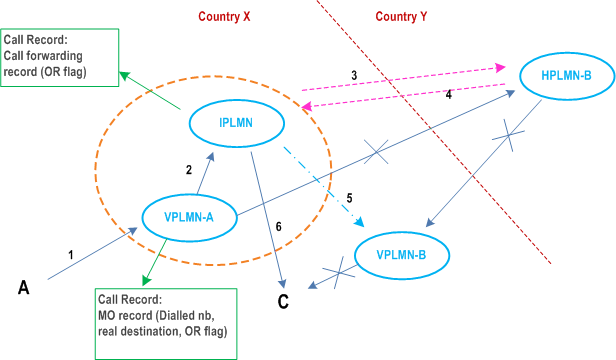
b) B is in the same country as A and C is in the same country as HPLMN-B
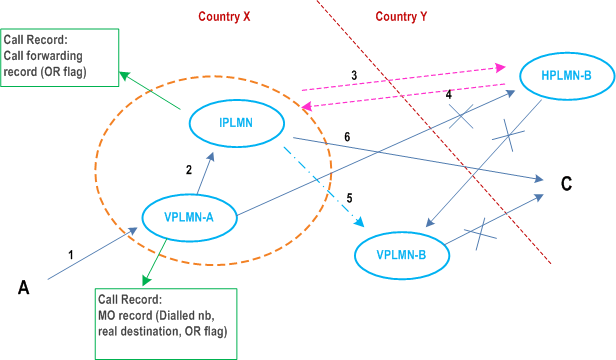
c) B is in her home country and C is in the same country as A
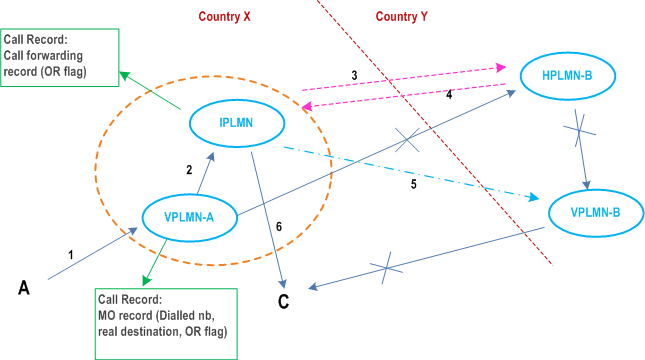
d) B and C are in the country of HPLMN-B
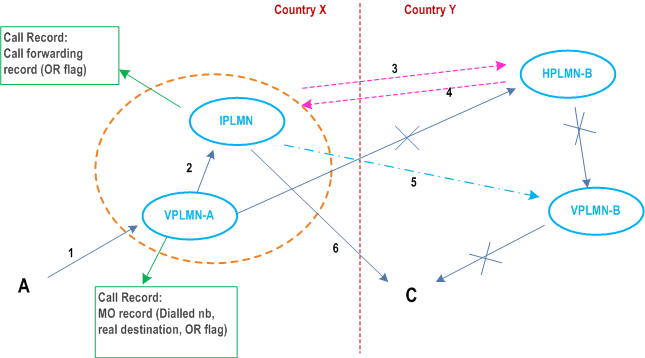
5.3 Exceptional procedures or unsuccessful outcome p. 13
5.3.1 Non-support of SOR in the VPLMN of the caller p. 13
If subscriber A roams into a network not supporting OR, she may not benefit from OR and only scenario 1 and scenario 2 of SOR are supported.
5.3.2 Non-support of SOR in the HPLMN of the B subscriber p. 13
If the HPLMN of the called party does not support SOR, SOR cannot be invoked and the route of the call as far as the called party's VPLMN cannot be optimised (the call would normally be routed via the HPLMN of the called party).
The same procedure shall be followed if the HPLMN operator denies OR on a subscriber basis.
5.3.3 Non support of SOR in the VPLMN of the B subscriber p. 13
If a subscriber whose HPLMN supports SOR registers in a VPLMN which does not support SOR, only the cases of Early Forwarded calls may be optimised.
5.3.4 Calls to special mobile network numbers p. 13
If the called number is a special mobile network number of the HPLMN, the HPLMN has to guarantee that the call terminates at its correct destination. This can be achieved by denying OR for this call by sending an appropriate error cause or by implementing a special handling.
6 Interactions of Optimal Routing with Supplementary Services p. 14
No Interaction unless it is stated differently below.
6.1 Call Forwarding p. 14
Interactions between SOR and Call Forwarding are dealt with in clause 5.
6.2 Call Barring p. 14
Outgoing Call Barring services are applied according to the dialled number.
Barring of Incoming calls when Roaming outside the HPLMN country will prevent calls to a mobile subscriber who has roamed outside her HPLMN country even if OR would result in no chargeable roaming leg.
The existing interactions between Call Forwardings and Call Barrings are not changed by the introduction of OR.
6.3 Call Transfer p. 14
A transferred call is considered as a set of two separate calls which may be separetely optimally routed.
Optimal Routing shall not be invoked as a result of the invocation of Call Transfer.
6.4 Call Deflection p. 14
A deflected call is considered as a late forwarded call and as such may be optimally routed.
6.5 Advice of Charge p. 14
Depending on call scenarios, AoC may not work properly.
7 Interactions of Optimal Routing with Operator Determined Barring (ODB) p. 14
The principles for the interaction between operator determined barring and SOR are the same as those for the interaction between Supplementary Service Call Barring and SOR.
8 Interactions of Optimal Routing with CAMEL p. 14
If CAMEL has to be applied to the Mobile Originating part of the call and if CAMEL modifies the destination of the call, the OR applies to any destination introduced by CAMEL.
If CAMEL has to be applied to the Mobile Terminating part of the call or a forwarding leg, the modified destination is treated for optimal routeing in the same way as a forwarded-to number.
If Barring services are also applicable to the call then they have to be handled first together with CAMEL before SOR is applied.